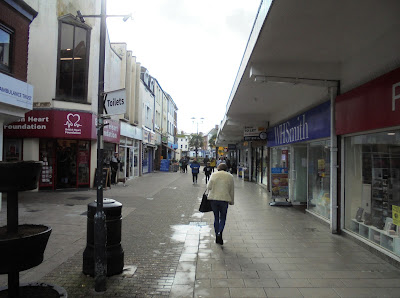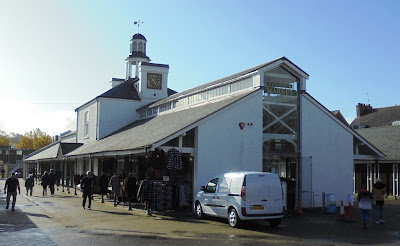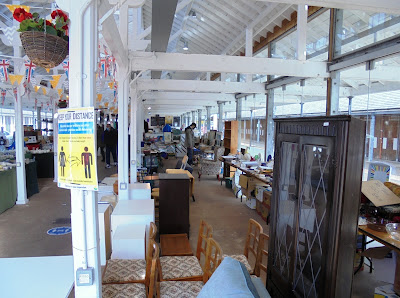When London was put into the Tier 2 COVID-19 alert level, Sue and I decided that if there was a chance that London might be moved up to Tier 3 before Christmas, we would go away for a long weekend whilst we could still travel. Unfortunately, as it is the week when many schools are taking their half-term holidays, the choice of places we could book at short notice was limited ... but Tiverton Castle did have some room. Furthermore, because we were returning so soon after our last visit, they offered us a discount on the cost.
Friday 23rd October: Tiverton
We set off by car at 11.00am ... and finally reached Tiverton at 4.45pm. The journey should have taken about four hours (including time for a comfort break), but a combination of roadworks, bad weather (i.e. torrential rain), and heavy traffic delayed our arrival. We were greeted by the owner’s wife, who gave us our keys and a very welcome coffee and walnut cake ... which we ate with a much-needed, refreshing cup of tea.
Suitably refreshed, we unpacked and settled in to our apartment, which forms part of the Castle’s wall. Sue and I decided to go out for dinner, and after a short walk into the centre of the town, we were able to eat in the Tiverton Steakhouse. We had eaten in this restaurant during our last visit to Tiverton, and enjoyed our meals there so much that it was a no-brainer to go there again.
Saturday 24th October: Exeter and Tiverton
Overnight, the weather took a turn for the worse, and by the time we had eaten breakfast, the rain was very heavy. We had planned to go to Killerton - a National Trust property between Tiverton and Exeter - after visiting the Marsh Barton area of Exeter, but as we were driving to Killerton from Exeter, the rain became torrential. Knowing that the distance between the car park and the main building was about a quarter of a mile, we knew that we would get soaked if we persisted with our planned visit ... so we returned to Tiverton to have lunch.
We bought some readymade rolls from a local bakery, and spent the early afternoon keeping warm and dry in our apartment. By 3.00pm, the rain has stopped, and Sue and I decided to go for a walk into Tiverton town centre. we had just reached the Pannier Market when it began to rain again. we did some shopping in several of the local shops before returning the the Castle.
During our walk back, we took a short detour up Castle Street to look at the local Masonic Centre.
Almost opposite is a plaque that explained that the alley leading from Castle Street to Tiverton Castle was known locally as Hippopotamus Court. This is a corruption of its original name - Hit and Miss Alley - and was the location of the tiltyard used by the. Castle’s garrison.
Tiverton Castle was one of ‘the ruins Cromwell knocked about a bit' during the English Civil War, and it was never repaired afterwards. Instead, it became a family home, and during the Georgian era a new house was built inside the grounds. Some parts of the original castle still exist, and these can be seen in the following photographs.
It was raining so hard at 7.00pm that we drove into the centre of Tiverton to have dinner for the second night running at the Tiverton Steakhouse.
For our main courses, Sue had Dover Sole and I ate Chicken Chasseur, and we followed that with Carrot Cake and Apple Pie.
We returned home after dinner, and spent the rest of the evening reading, resting, and watching TV.
Sunday 25th October: Exmouth and Exeter
Having gained an extra hour due to the clocks going back at the end of British Summer Time, Sue and I hoped that the change would be marked by a general improvement in the weather ... and it was! We awoke to find the sun shining, and decided that we would visit Exmouth.
Sue and I set off after breakfast, and reached Exmouth at 11.20am. There was plenty of space in the town centre car park, and we spent the next hour wandering around.
We then drove to the seafront ... which was surprisingly crowded. There seemed to be more people on the beach than there had been during our last visit, and we discussed the possibility of staying in Exmouth for lunch.
Sue and I had a short walk along the Esplanade, ...
... from where we could see three cruise liners at anchor on the other side of the estuary.
During our walk, the sky began to darken quite rapidly, and it soon became apparent that it was going to rain. Rather than stay in Exmouth and get wet, Sue and I decided to go to central Exeter. The drive took about forty-five minutes, and we had no difficulty parking in the Princesshay Car Park.
We stayed in central Exeter for nearly three hours, and besides doing some serious retail therapy, we ate an excellent lunch in the local branch of the Zizzi chain of Italian restaurants. It is situated in Gandy Street, just off the High Street.
We also had the opportunity to take a look at Exeter Cathedral, which is currently undergoing some restoration work.
On our drive back to Tiverton, it began to get dark, and the rain we had avoided in Exmouth caught up with us. By the time we reached Tiverton Castle, the rain was torrential, and we had to dash from the car to our front door to ensure that we were not soaked. We then spent the rest of the afternoon reading and resting.
Because we had eaten a big lunch, Sue and I only had a snack for our evening meal. This meant that we did not have to go out to eat ... which was probably just as well, as the weather had remained wet and windy.
Monday 26th October: Tiverton and Wellington
It was sunny when we awoke, but it looked as if it had been raining. After breakfast, Sue and I paid a visit to the Pannier Market in Tiverton.
Monday is the day of the week when half of the market is turned over to the sale of second-hand and antique articles, and we had an interesting time looking at what was on sale. I considered buying a copy of WITH THE FLAG TO PRETORIA, but it was not in very good condition and I decided that it was overpriced.
It began to rain just after we left the Market, and we sheltered from the rain in several of the local shops. Once it had stopped, we explored parts of the town we had not seen before. It was whilst we were doing this that the hospital telephoned me with the results of my recent colonoscopy. I took the call whilst sitting in a small garden just off the town’s main shopping street, where there was a small memorial that had been erected by the Burma Star Association.
The news rather took the wind out of my sails, and we returned home to Tiverton Castle for a drink and a chat about what to do.
In the end, we decided that rather than sit in our apartment thinking about the results, it would be better to go out somewhere. After a quick look at a map of Devon and. Somerset, we chose to go to Wellington. We drove there across country using mainly B-class roads ... which proved ‘interesting’! (Some of the roads were only just wide enough for one vehicle. Luckily, we did not meet any other vehicles coming in the other direction.)
Wellington was relatively deserted, and many of the businesses were closed.
Sue and I made our way to Wellington Park, where there was a rather unusual war memorial to the dead of the two World Wars.
After looking for somewhere to eat lunch, we ended up in a local pub called - appropriately - The Iron Duke.
We struggled a bit with the ‘order your food and drink using the app’, but we persisted ... and ended up with exactly what we wanted! The food was better than we expected, and we were struck by the excellent COVID-secure environment.
The sun was shining as we drove home, and after our earlier cross-country journey, we used the M5 and A361 to get back to Tiverton. We arrive back at the Castle just before 4.15pm, just as it was beginning to get dark. We stayed there reading and resting until it was time to go out for dinner. For our last night in Tiverton, we returned to the Branzino Italian Restaurant.
Sue and I both ate pizza, and then walked back to the Castle to do some packing before watching TV until it was time to go to bed.
Tuesday 27th October: Going home
We had packed our car by 10.00am, and after a short diversion to fill up with petrol at a local filling station, we set off for home. It rained almost all the way home, and this affected the time it took us to get back. (A four-hour journey took slightly more than five hours.) We managed to take a short comfort break at Weyhill Services on the A303, but the main delays were due to restricted visibility because of the heavy rain, roadworks in the Amesbury/Stonehenge area, and to heavy traffic between Junctions 3 and 2 on the M25 approach to the Dartford Crossing.
































































































